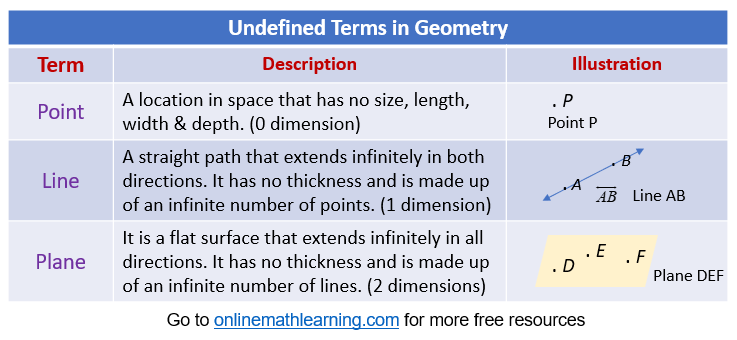Geometry Building Blocks
This is a series of free, online High School Geometry video lessons and solutions.
Videos, worksheets, solutions, and activities to help Geometry students.
In these lessons, we will learn
- point, line and plane
- counterexample
- what is a good geometry definition
- postulate, axiom and conjecture
Three Undefined Terms: Point, Line, and Plane
In geometry, there are three undefined terms that form the foundation for defining all other geometric concepts. These terms are considered “undefined” because they are so basic that they cannot be defined using simpler terms. Instead, they are understood through examples and descriptions. The three terms are point, line and plane.
- Point
A point is a location in space that has no size, no length, no width, and no depth. (0 dimension)
It is represented by a dot and named using a capital letter (e.g., Point A). - Line
A line is a straight path that extends infinitely in both directions. (1 dimension)
It has no thickness and is made up of an infinite number of points.
It is named using any two points on the line (e.g., Line AB) - Plane
A plane is a flat, two-dimensional surface that extends infinitely in all directions.
It has no thickness and is made up of an infinite number of lines.
It is named using three non-collinear points or a capital letter (e.g., Plane ABC or Plane P).
The following diagram gives a summary of the three undefined terms in geometry: point, line, and plane.

Explains and demonstrates the fundamental concepts (undefined terms) of geometry: point, line, plane
Basic geometry concepts
A visual 3-Dimensional Demonstration of points, lines, and planes
Counterexample
Throughout Geometry, students write definitions and test conjectures using counterexamples. When writing definitions, counterexamples are useful because they ensure a complete and unique description of a term. If a counterexample does not exist for a conjecture (an if - then statement), then the conjecture is true.
This is a demonstration of the counterexample method.
How to use a counterexample to prove a definition or conjecture incorrect.
A counterexample is a way to prove a statement as being false.
This video gives 4 example problems explaining counterexamples to conditional statements.
The first 2 examples are the basics behind counterexamples.
The last 2 examples are problems you’d probably see on a quiz or test.
Examples:
- Find the counterexample to the following conditional statement.
“If you are a high school student, then you walk to school” - Find the counterexample to the following conditional statement.
“If you have a dog, then its name is Spot” - What is a counterexample to the following statement?
“All angles are equal to or more than 90 degrees?"
a) Obtuse angles
b) Acute angles
c) Straight angles
d) Right angles - What is a counterexample to the following statement?
“All quadrilaterals have parallel sides?"
a) Rhombus
b) Square
c) Kite
d) Trapezoid
Good Geometry Definition
Writing a definition is a common exercise during the early stages of Geometry.
An excellent geometry definition will classify, quantify, and not have a counterexample.
Once a term is defined, it can be used in subsequent definitions; for example, once parallel lines are defined, they can be used in the definition of a parallelogram.
How to write a good definition that does not have a counterexample?
Postulate, Axiom, Conjecture
Three words that are used seemingly interchangeably in Geometry are postulate, axiom, and conjecture.
It is important, however, to know how each word is different and to know the subtle implications of using each word.
These terms are especially important when working with Geometry proofs.
How to differentiate between the words postulate, axiom, and conjecture?
Try the free Mathway calculator and
problem solver below to practice various math topics. Try the given examples, or type in your own
problem and check your answer with the step-by-step explanations.

We welcome your feedback, comments and questions about this site or page. Please submit your feedback or enquiries via our Feedback page.